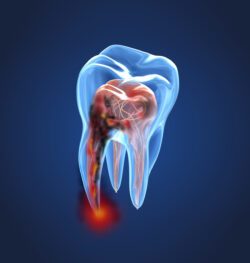Root Canal An Overview
Although often referred to as a painful procedure, today’s patients enjoy the benefits of advanced techniques that have made the root canal process less uncomfortable. In fact, the root canal procedure is no more painful than having a dental filling. The pain associated with a root canal actually comes from the infection itself. A root canal procedure can quickly and easily alleviate the pain.
A root canal is an important procedure for saving your natural tooth from extraction and maintaining the natural structure of your bite. For this reason, Dr. Brown and Dr. Newberry recommend a root canal whenever possible and refer patients to local specialists for treatment. In most cases, we will place a dental crown following the root canal to support the integrity of the tooth and your long-term oral health.
The Structure of a Tooth
The term “root canal” refers to the natural cavity at the tooth’s center. The tooth’s nerve is located inside the root canal, surrounded by soft tissue called pulp.
If the tooth is damaged or has decay, bacteria, and debris can enter the root canal area and cause an infection. In severe cases, an abscess can occur, which requires immediate treatment to prevent infection from spreading to the rest of the body.

Root Canal FAQs
The specialist performing your root canal will provide specific treatment information for your unique situation, but here are answers to common questions regarding the root canal procedure. Our dental care team will follow up with you after your root canal and continue to monitor the condition of your tooth at routine dental care visits.
Is it better to remove a damaged tooth or get a root canal?
We recommend getting a root canal before deciding to remove the tooth altogether in order to have great oral health for years to come. Having as many healthy natural teeth as possible helps prevent jawbone deterioration, premature facial sagging, and more. They are your first line of defense against many dental issues that arise with missing teeth.
What kind of anesthesia is used for a root canal?
Getting a root canal treatment is similar to getting a dental filling. Local anesthesia is used to numb your mouth. It is usually applied as a numbing gel without the use of needles. You will not feel pain or discomfort but will still be awake and aware of what’s going on.
Can you get an infection after a root canal?
Yes, infections are still possible after a root canal if you do not follow post-treatment instructions and neglect your oral health. A root canal and crown will protect your tooth to a certain extent, but it is up to you to maintain great oral health and make routine visits to the dentist.
How do you know if your root canal is infected?
When a root canal gets infected patients may notice a green or yellow discharge coming from the area. They may also notice that the area is red and swollen. The area may also feel warm. In some extreme cases, patients’ faces and necks may be swollen and numb, or tender. If you find yourself experiencing any of these symptoms after having a root canal reach out to your dentist as soon as possible.
Is it OK to take ibuprofen before a root canal?
Many patients tell their patients to take ibuprofen prior to coming in for their root canal. This can help with swelling and relieve some pain throughout the procedure. Ibuprofen is an anti-inflammatory and works to reduce pain.
Can they put me to sleep for a root canal?
It is not recommended to be sedated for a root canal. In most cases, this only puts a patient’s body through unwarranted stress. Patients may wish to be sedated if they suffer from extreme dental anxiety or have special needs. In most of these cases, nitrous oxide will be used.
Do I need a root canal if my tooth doesn’t hurt?
Not necessarily. While a root canal will help with pain relief, dentists also use it to treat infected or damaged teeth that do not cause pain. Dr. Prendergast will assess the health of your tooth and recommend the best course of action, which might include a root canal to prevent future issues.
How long does it take to recover from a root canal?
The recovery time after root canal therapy is typically a few days to a week. During this time, you may experience some sensitivity and discomfort, which you can manage with over-the-counter pain medication. Following all the post-operative care instructions is essential for a smooth and quick recovery.
Are there any alternatives to root canal treatment?
Yes, you have other choices besides root canal therapy. However, they depend on the severity of the issue. For minor cases, a filling or crown might suffice. In more severe cases, Dr. Prendergast may need to extract the tooth and replace it with dental restoration such as a bridge or implant-supported dental crown. We will help you through this process after a consultation.
Will my dental insurance cover root canal treatment?
Dental insurance coverage for root canal therapy is different for everyone. Some dental plans cover a portion of the cost while , especially if it’s deemed medically necessary. It’s best to check with your insurance provider and review your policy to understand the extent of coverage for root canal procedures.
